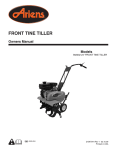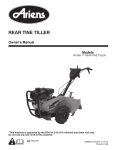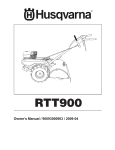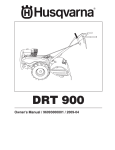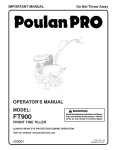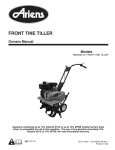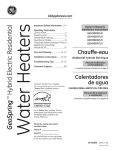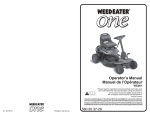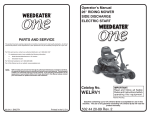Download Ariens 90102800 Owner`s manual
Transcript
REAR TINE TILLER Owner's Manual Models 90102800 17" REAR TINE TILLER %.',)3( 21547000 427490 Rev. 1 03.18.09 Printed in USA SAFETY RULES Safe Operation Practices for Walk-Behind Powered Rotary Tillers TRAINING • • • • • Read the Owner’s Manual carefully. Be thoroughly familiar with the controls and the proper use of the equipment. Know how to stop the unit and disengage the controls quickly. Never allow children to operate the equipment. Never allow adults to operate the equipment without proper instruction. Keep the area of operation clear of all persons, particularly small children, and pets. • • • • • PREPARATION • • • • • • • • • • Thoroughly inspect the area where the equipment is to be used and remove all foreign objects. Disengage all clutches and shift into neutral before starting the engine (motor). Do not operate the equipment without wearing adequate outer garments. Wear footwear that will improve footing on slippery surfaces. Handle fuel with care; it is highly flammable. Use an approved fuel container. Never add fuel to a running engine or hot engine. Fill fuel tank outdoors with extreme care. Never fill fuel tank indoors. Replace gasoline cap securely and clean up spilled fuel before restarting. Use extension cords and receptacles as specified by the manufacturer for all units with electric drive motors or electric starting motors. Never attempt to make any adjustments while the engine (motor) is running (except where specifically recommended by manufacturer). MAINTENANCE AND STORAGE • • • • • • • • • • • • Keep machine, attachments, and accessories in safe working condition. Check shear pins, engine mounting bolts, and other bolts at frequent intervals for proper tightness to ensure the equipment is in safe working condition. Never store the machine with fuel in the fuel tank inside a building where ignition sources are present, such as hot water and space heaters, clothes dryers, and the like. Allow the engine to cool before storing in any enclosure. Always refer to the operator’s guide instructions for important details if the tiller is to be stored for an extended period. - IMPORTANT CAUTIONS, IMPORTANTS, AND NOTES ARE A MEANS OF ATTRACTING ATTENTION TO IMPORTANT OR CRITICAL INFORMATION IN THIS MANUAL. IMPORTANT: USED TO ALERT YOU THAT THERE IS A POSSIBILITY OF DAMAGING THIS EQUIPMENT. OPERATION • • Keep children and pets away. Do not overload the machine capacity by attempting to till too deep at too fast a rate. Never operate the machine at high speeds on slippery surfaces. Look behind and use care when backing. Never allow bystanders near the unit. Use only attachments and accessories approved by the manufacturer of the tiller. Never operate the tiller without good visibility or light. Be careful when tilling in hard ground. The tines may catch in the ground and propel the tiller forward. If this occurs, let go of the handlebars and do not restrain the machine. Do not put hands or feet near or under rotating parts. Exercise extreme caution when operating on or crossing gravel drives, walks, or roads. Stay alert for hidden hazards or traffic. Do not carry passengers. After striking a foreign object, stop the engine (motor), remove the wire from the spark plug, thoroughly inspect the tiller for any damage, and repair the damage before restarting and operating the tiller. Exercise caution to avoid slipping or falling. If the unit should start to vibrate abnormally, stop the engine (motor) and check immediately for the cause. Vibration is generally a warning of trouble. Stop the engine (motor) when leaving the operating position. Take all possible precautions when leaving the machine unattended. Disengage the tines, shift into neutral, and stop the engine. Before cleaning, repairing, or inspecting, shut off the engine and make certain all moving parts have stopped. Disconnect the spark plug wire, and keep the wire away from the plug to prevent accidental starting. Disconnect the cord on electric motors. Do not run the engine indoors; exhaust fumes are dangerous. Never operate the tiller without proper guards, plates, or other safety protective devices in place. NOTE: Gives essential information that will aid you to better understand, incorporate, or execute a particular set of instructions. Look for this symbol to point out important safety precautions. It means CAUTION!!! BECOME ALERT!!! YOUR SAFETY IS INVOLVED. CAUTION: Always disconnect spark plug wire and place wire where it cannot contact spark plug in order to prevent accidental starting when setting up, transporting, adjusting or making repairs. WARNING The engine exhaust from this product contains chemicals known to the State of California to cause cancer, birth defects, or other reproductive harm. 2 PRODUCT SPECIFICATIONS CUSTOMER RESPONSIBILITIES • • Read and observe the safety rules. Follow a regular schedule in maintaining, caring for and using your tiller. Follow instructions under “Maintenance” and “Storage” sections of this Manual. Gasoline Capacity: 3.6 Quarts (3.4L) Unleaded Regular Oil (API-SG-SL): (Capacity: 20 oz./0.6L) SAE 10w-30 (Above 32°F/0°C) SAE 5w-30 (Below 32°F/0°C) • Spark Plug: (Gap: .030"/0.76mm) NGK BR-5HS (Champion RL86C) IMPORTANT: THIS UNIT IS EQUIPPED WITH AN INTERNAL COMBUSTION ENGINE AND SHOULD NOT BE USED ON OR NEAR ANY UNIMPROVED FOREST-COVERED, BRUSHCOVERED OR GRASS COVERED LAND UNLESS THE ENGINE'S EXHAUST SYSTEM IS EQUIPPED WITH A SPARK ARRESTER MEETING APPLICABLE LOCAL LAWS (IF ANY). IF A SPARK ARRESTER IS USED, IT SHOULD BE MAINTAINED IN EFFECTIVE WORKING ORDER BY THE OPERATOR. IN THE STATE OF CALIFORNIA, A SPARK ARRESTER IS REQUIRED BY LAW (SECTION 4442 OF THE CALIFORNIA PUBLIC RESOURCES CODE). OTHER STATES MAY HAVE SIMILAR LAWS. FEDERAL LAWS APPLY ON FEDERAL LANDS. SEE YOUR AUTHORIZED SERVICE CENTER/DEPARTMENT FOR SPARK ARRESTER. CONGRATULATIONS on your purchase of a new tiller. It has been designed, engineered and manufactured to give you the best possible dependability and performance. Should you experience any problems you cannot easily remedy, please contact your nearest authorized service center. We have competent, well-trained technicians and the proper tools to service or repair this unit. Please read and retain this manual. The instructions will enable you to assemble and maintain your tiller properly. Always observe the “SAFETY RULES." TABLE OF CONTENTS MAINTENANCE ..................................................... 10-13 SERVICE & ADJUSTMENTS ................................. 14-16 STORAGE .................................................................... 16 TROUBLESHOOTING ................................................. 17 PARTS..................................................................... 18-31 WARRANTY............................................................ 32-33 PARTS AND SERVICE ................................................ 34 SAFETY RULES ............................................................ 2 PRODUCT SPECIFICATIONS ....................................... 3 CUSTOMER RESPONSIBILITIES................................. 3 ASSEMBLY ................................................................. 4-5 OPERATION ............................................................. 6-10 MAINTENANCE SCHEDULE ...................................... 11 3 ASSEMBLY Your new tiller has been assembled at the factory with exception of those parts left unassembled for shipping purposes. To ensure safe and proper operation of your tiller all parts and hardware you assemble must be tightened securely. Use the correct tools as necessary to ensure proper tightness. CONTENTS OF HARDWARE PACK (1) Carriage Bolt 3/8-16 UNC x 1 Grade 5 (2) Handle Locks (1) Flat Washer 13/32 x 1 x 11 Gauge (1) Center Locknut 3/8-16 UNC (1) Handle Lock Lever (1) Pivot Bolt 3/8-16 UNC Grade 5 (1) Hairpin Clip Extra Shear Pins & Clips TOOLS REQUIRED FOR ASSEMBLY UNPACKING CARTON (See Fig. 2) A socket wrench set will make assembly easier. Standard wrench sizes are listed. (1) Utility knife (1) Tire pressure gauge (1) Pair of pliers (1) 9/16" wrench CAUTION: Be careful of exposed staples when handling or disposing of cartoning material. IMPORTANT: WHEN UNPACKING AND ASSEMBLING TILLER, BE CAREFUL NOT TO STRETCH OR KINK CABLES. • OPERATOR’S POSITION (See Fig. 1) • • When right or left hand is mentioned in this manual, it means when you are in the operating position (standing behind tiller handles). • FRONT • While holding handle assembly, cut cable ties securing handle assembly to top frame. Let handle assembly rest on tiller. Remove top frame of carton. Slowly ease handle assembly up and place on top of carton. Cut down right hand front and right hand rear corners of carton. Lay side carton wall down. Remove packing material from handle assembly. SHIFT ROD LEFT RIGHT HANDLE ASSEMBLY OPERATOR’S POSITION Fig. 1 Fig. 2 4 ASSEMBLY INSTALL HANDLE (See Figs. 3, 4, and 5) • Insert one handle lock (with teeth facing outward) in gearcase notch. (Apply grease on smooth side of handle lock to aid in keeping lock in place until handle assembly is lowered into position.) GEARCASE SLOT REAR CARRIAGE BOLT VIEWED FROM R.H. SIDE OF TILLER HANDLE ASSEMBLY SILVER HANDLE LOCK FLAT WASHER HANDLE LOCK LEVER PIVOT BOLT GEARCASE NOTCH HANDLE LOCK LOCKNUTS s_34 le hand HANDLE BASE Fig. 5 CONNECT SHIFT ROD (See Fig. 6) • • Fig. 3 • Insert end of shift rod into hole of shift lever indicator. Insert hairpin clip through hole of shift rod to secure with bend of clip on right side. Grasp handle assembly. Hold in “up” position. Ensure handle lock remains in gearcase notch. Slide handle assembly into position. SHIFT ROD HANDLE ASSEMBLY "UP" POSITION HAIRPIN CLIP SHIFT LEVER INDICATOR TIGHTEN HANDLE LOCK LEVER TO HOLD LOOSEN HANDLE LOCK LEVER TO MOVE • • • • • • • • Fig. 6 REMOVE TILLER FROM CRATE Fig. 4 Rotate handle assembly down. Insert rear carriage bolt first, with bolt head on L.H. side of tiller and loosely assemble locknut (See Fig. 5). Insert pivot bolt in front part of plate and tighten. Cut down remaining corners of carton and lay panels flat. Lower the handle assembly. Tighten nut on carriage bolt so handle moves with some resistance. This will allow for easier adjustment. Place flat washer on threaded end of handle lock lever. Insert handle lock lever through handle base and gearcase. Screw in handle lock lever just enough to hold lever in place. Insert second handle lock (with teeth inward) in the slot of the handle base (just inside of washer). With handle assembly in lowest position, securely tighten handle lock lever by rotating clockwise. Leaving handle assembly in lowest position will make it easier to remove tiller from carton. • • • Ensure shift lever indicator is in “N” position (See Fig. 6). Tilt tiller forward by lifting handle. Separate cardboard cover from leveling shield. Rotate tiller handle to the right and pull tiller out of carton. CHECK TIRE PRESSURE The tires on your unit were overinflated at the factory for shipping purposes. Correct and equal tire pressure is important for best tilling performance. • Reduce tire pressure to 20 PSI (1.4 kg/cm2). HANDLE HEIGHT • 5 Handle height may be adjusted to better suit operator. (See “TO ADJUST HANDLE HEIGHT” in the Service and Adjustments section of this manual.) OPERATION KNOW YOUR TILLER READ THIS OWNER'S MANUAL AND SAFETY RULES BEFORE OPERATING YOUR TILLER. Compare the illustrations with your tiller to familiarize yourself with the location of various controls and adjustments. Save this manual for future reference. These symbols may appear on your Tiller or in literature supplied with the product. Learn and understand their meaning. TILLING TILLING FORWARD NEUTRAL REVERSE CAUTION OR WARNING ENGINE ON ENGINE OFF FAST SLOW CHOKE FUEL VALVE SHIFT LEVER FUEL THROTTLE CONTROL CHOKE CONTROL TINE CONTROL OIL ENGINE ON/OFF SWITCH SHIFT LEVER INDICATOR DRAG STAKE DEPTH STAKE LEVELING SHIELD RECOIL STARTER HANDLE OUTER SIDE SHIELD Fig. 7 MEETS ANSI SAFETY REQUIREMENTS Our tillers conform to the safety standards of the American National Standards Institute. CHOKE CONTROL - Used when starting a cold engine. DEPTH STAKE - Controls depth at which tiller will dig. DRAG STAKE - Controls forward speed in forward rotating till position. ENGINE ON/OFF SWITCH - The engine switch enables and disables the ignition system. FUEL VALVE - The fuel valve opens and closes the passage between the fuel tank and the carburetor. TINE CONTROL - Used to engage tines. LEVELING SHIELD - Levels tilled soil. OUTER SIDE SHIELD - Adjustable to protect small plants from being buried. RECOIL STARTER HANDLE - Used to start the engine. SHIFT LEVER - Used to shift transmission gears. SHIFT LEVER INDICATOR - Shows which gear the transmission is in. THROTTLE CONTROL - Controls engine speed. 6 OPERATION 00155 The operation of any tiller can result in foreign objects thrown into the eyes, which can result in severe eye damage. Always wear safety glasses or eye shields before starting your tiller and while tilling. We recommend a wide vision safety mask for over spectacles or standard safety glasses. HOW TO USE YOUR TILLER TINE OPERATION - WITH WHEEL DRIVE • Know how to operate all controls before adding fuel and oil or attempting to start engine. • STOPPING (See Fig. 8) TINES AND DRIVE 1. Release tine control to stop movement. 2. Move shift lever indicator to “N” (neutral) position. ENGINE 3. Set the speed control lever at the low speed position and allow the engine to run at low speed for 1 or 2 minutes before stopping. 4. Turn the ENGINE SWITCH counterclockwise to the position “ O ” (OFF). 5. Close the fuel valve. 6. Pull the starter handle slowly and return the handle to its original position when resistance is felt. This operation is necessary to prevent outside moist air from intruding into the combustion chamber. NOTE: Never use choke to stop engine. FORWARD - WHEELS ONLY/TINES STOPPED • Release tine control and move shift lever indicator to “F” (forward) position. Engage tine control and tiller will move forward. REVERSE - WHEELS ONLY/TINES STOPPED • • • • • DO NOT STAND DIRECTLY BEHIND TILLER. Release the tine control. Move throttle control to “SLOW” position. Move shift lever indicator to “R” (reverse) position. Hold tine control against the handle to start tiller movement. HARD TO SHIFT GEARS • IMPORTANT: TO STOP ENGINE IN AN EMERGENCY, TURN THE ENGINE SWITCH TO THE OFF POSITION. Briefly engage tine control and release or rock tiller forward and backward until are able to shift gears. DEPTH STAKE (See Fig. 9) TINE CONTROL “ON” (UP) POSITION The depth stake can be raised or lowered to allow you more versatile tilling and cultivating, or to more easily transport your tiller. TINE CONTROL “OFF” (DOWN) POSITION THROTTLE CONTROL Always release tine control before moving shift lever into another position. Tine movement is achieved by moving shift lever to either the counter rotating ( ) till position or the forward rotating ( ) till position and engaging tine control. ENGINE SWITCH TRANSPORT POSITION SHALLOWEST TILLING (CULTIVATING) FUEL VALVE DEEPEST TILLING DEPTH STAKE 2 ke_ sta th_ dep Fig. 9 ENGINE SWITCH THROTTLE CONTROL RECOIL STARTER FUEL VALVE Fig. 8 7 OPERATION DRAG STAKE (See Fig. 10) TURNING • • • The drag stake should be raised when tilling in the counter rotating ( ) till position. The drag stake should be lowered when tilling in the forward rotating ( )till position. • • LOWERED (FORWARD ROTATING TILL) • CULTIVATING depth_stake_10 RAISED (COUNTER ROTATING TILL) • • Fig. 10 TILLING (See Fig. 11) • • • • Release the tine control. Move throttle control to “SLOW” position. Place shift lever indicator in “F” (forward) position. Tines will not turn. Lift handle to raise tines out of ground. Swing the handle in the opposite direction you wish to turn, being careful to keep feet and legs away from tines. When you have completed your turn-around, release the tine control and lower handle. Place shift lever in (till) position and move throttle control to desired speed. To begin tilling, hold tine control against the handle. Release depth stake pin. Pull the depth stake up for increased tilling depth. Place depth stake pin in hole of depth stake to lock in position. Place shift lever indicator in counter rotating ( ) till position . Hold the tine control against the handle to start tilling movement. Tines and wheels will both turn. Move throttle control to “FAST” position for deep tilling. To cultivate, throttle control can be set at any desired speed, depending on how fast or slow you wish to cultivate. • • • • Use the forward rotating tine drive when cultivating, tilling soft ground or tilling pre-tilled soil. Release depth and drag stake pins. Lower drag stake. Pull the depth stake up for increased tilling depth. Place proper pin in hole of depth stake or drag stake to lock in position. Place shift lever indicator in forward rotating ( ) till position. Hold the tine control against the handle to start tilling movement. Tines and wheels will both turn. Move throttle control "FAST" position for deep tilling. To cultivate, throttle control can be set at any desired speed, depending on how fast or slow you wish to cultivate. Always lower the drag stake when using the forward rotating tine drive. OUTER SIDE SHIELDS (See Fig. 11) IMPORTANT: ALWAYS RELEASE TINE CONTROL BEFORE MOVING SHIFT LEVER INTO ANOTHER POSITION. The back edges of the outer side shields are slotted so that the shields can be raised for deep tilling and lowered for shallow tilling to protect small plants from being buried. Loosen nut “A” in slot and nut “B”. Move shield to desired position (both sides). Retighten nuts. DEPTH STAKE PIN “RELEASED” POSITION TO TRANSPORT CAUTION: Before lifting or transporting, allow tiller engine and muffler to cool. Disconnect spark plug wire. Drain gasoline from fuel tank. “LOCKED” POSITION AROUND THE YARD • Release the depth stake pin. Move the depth stake down to the top hole for transporting the tiller. Place depth stake pin in hole of depth stake to lock in position. This prevents tines from scuffing the ground. • Place shift lever indicator in “F” (forward) position for transporting. • Hold the tine control against the handle to start tiller movement. Tines will not turn. • Move throttle control to desired speed. NUT “B” OUTER SIDE SHIELD 11 NUT “A” s h_ _ ke ta t p de Fig. 11 AROUND TOWN • Disconnect spark plug wire. • Drain fuel tank. • Transport in upright position to prevent oil leakage. 8 OPERATION BEFORE STARTING ENGINE IMPORTANT: WHEN OPERATING IN TEMPERATURES BELOW 32°F(0°C), USE FRESH, CLEAN WINTER GRADE GASOLINE TO HELP ENSURE GOOD COLD WEATHER STARTING. IMPORTANT: BE VERY CAREFUL NOT TO ALLOW DIRT TO ENTER THE ENGINE WHEN CHECKING OR ADDING OIL OR FUEL. USE CLEAN OIL AND FUEL AND STORE IN APPROVED, CLEAN, COVERED CONTAINERS. USE CLEAN FILL FUNNELS. CAUTION: Alcohol blended fuels (called gasohol or using ethanol or methanol) can attract moisture which leads to separation and formation of acids during storage. Acidic gas can damage the fuel system of an engine while in storage. To avoid engine problems, the fuel system should be emptied before storage of 30 days or longer. Drain the gas tank, start the engine and let it run until the fuel lines and carburetor are empty. Use fresh fuel next season. See Storage Instructions for additional information. Never use engine or carburetor cleaner products in the fuel tank or permanent damage may occur. CHECK ENGINE OIL LEVEL (See Fig. 12) • The engine in your unit has been shipped, from the factory, already filled with SAE 30 summer weight oil. • With engine level, clean area around oil filler plug and remove plug. • Engine oil should be to point of overflowing when engine is level. For approximate capacity see “PRODUCT SPECIFICATIONS” on page 3 of this manual. All oil must meet A.P.I. Service Classification SF-SJ. • For cold weather operation you should change oil for easier starting (See oil viscosity chart in the Maintenance section of this manual). • To change engine oil, see the Maintenance section in this manual. TO START ENGINE (See Fig. 13) CAUTION: Keep tine control in “OFF” position when starting engine. 1. 2. 3. 4. Move shift lever indicator to “N” (neutral) position. Open the fuel valve. Turn the ENGINE SWITCH to the position “ I ” (ON). Set the speed control lever 1/3 of the way towards the high speed position. 5. Close the choke lever. NOTE: If the engine is cold or the ambient temperature is low, close the choke lever fully. NOTE: If the engine is warm or the ambient temperature is high, open the choke lever half-way, or keep it fully open. 6. Pull the starter handle slowly until resistance is felt. This is the “compression” point. Return the handle to its original position and pull swiftly. Do not pull out the rope all the way. After starting the engine, allow the starter handle to return to its original position while still holding the handle. 7. After starting the engine, gradually open choke by turning the choke lever and finally keep it fully opened. Do not fully open the choke lever immediately when the engine is cold or the ambient temperature is low, because the engine may stop. NOTE: If engine does not start, see troubleshooting points. OIL FILLER PLUG OIL LEVEL MAXIMUM UPPER LEVEL MINIMUM UPPER LEVEL Fig. 12 ADD GASOLINE • Fill fuel tank to bottom of filler neck. Do not overfill. Use fresh, clean, regular unleaded gasoline with a minimum of 87 octane. (Use of leaded gasoline will increase carbon and lead oxide deposits and reduce valve life.) Do not mix oil with gasoline. Purchase fuel in quantities that can be used within 30 days to assure fuel freshness. CAUTION: Fill to within 1/2 inch of top of fuel tank to prevent spills and to allow for fuel expansion. If gasoline is accidentally spilled, move machine away from area of spill. Avoid creating any source of ignition until gasoline vapors have disappeared. Wipe off any spilled oil or fuel. Do not store, spill or use gasoline near an open flame. ENGINE SWITCH THROTTLE CONTROL SPARK PLUG RECOIL STARTER CHOKE CONTROL FUEL VALVE Fig. 13 9 OPERATION TILLING HINTS (See Fig. 14) • CAUTION: Until you are accustomed to handling your tiller, start actual field use with throttle in slow position (mid-way between “FAST” and “IDLE”). • • • • • Tilling is digging into, turning over, and breaking up packed soil before planting. Loose, unpacked soil helps root growth. Best tilling depth is 4" to 6" (10-15 cm). A tiller will also clear the soil of unwanted vegetation. The decomposition of this vegetable matter enriches the soil. Depending on the climate (rainfall and wind), it may be advisable to till the soil at the end of the growing season to further condition the soil. You will find tilling much easier if you leave a row untilled between passes. Then go back between tilled rows. (See Fig. 14) There are two reasons for doing this. First, wide turns are much easier to negotiate than about-faces. Second, the tiller won’t be pulling itself, and you, toward the row next to it. Soil conditions are important for proper tilling. Tines will not readily penetrate dry, hard soil which may contribute to excessive bounce and difficult handling of your tiller. Hard soil should be moistened before tilling; however, extremely wet soil will “ball-up” or clump during tilling. Wait until the soil is less wet in order to achieve the best results. When tilling in the fall, remove vines and long grass to prevent them from wrapping around the tine shaft and slowing your tilling operation. Do not lean on handle. This takes weight off the wheels and reduces traction. To get through a really tough section of sod or hard ground, apply upward pressure on handle or lower the depth stake. 3 4 5 2 6 Do not lean on handle, this takes weight off the wheels, reduces traction, and may cause the tiller to skip over the ground. Always lower the drag stake when using the forward rotating tine drive. Fig. 15 ADJUST WHEELS FOR CULTIVATING (See Figs. 16 and 17) • Place blocks under right hand side of tiller and remove hairpin clip and clevis pin from right hand wheel. • Move wheel outward approximately 1 inch until hole in inner wheel hub lines up with inner hole in axle. • Replace clevis pin and hairpin clip on inside of wheel and remove blocks. • Repeat preceding steps on left hand side. NOTE: In extremely rough conditions and while cultivating, the wheels should be moved outward on the axle for increased stability. OUTER VIEW OF TIRE 1 CLEVIS PIN 7 HAIRPIN CLIP Fig. 16 INNER VIEW OF TIRE Fig. 14 CULTIVATING Cultivating is destroying the weeds between rows to prevent them from robbing nourishment and moisture from the plants. At the same time, breaking up the upper layer of soil crust will help retain moisture in the soil. Best digging depth is 1" to 3" (2.5-7.5 cm). Lower the outer side shields to protect small plants from being buried. • Cultivate up and down the rows at a speed which will allow tines to uproot weeds and leave the ground in rough condition, promoting no further growth of weeds and grass (See Fig. 15). CLEVIS PIN HAIRPIN CLIP 10 Fig. 17 &),,ª).ª$!4%3 !3ª9/5ª#/-0,%4% 2%'5,!2ª3%26)#% "% &/ 2 -!).4%.!.#% 3#(%$5,% %ª% %6 !# %2 (ª 53 9ª % ª (/ %6 52 %2 9ª 3 ª( %6 / %2 52 9ª 3 %6 ª( %2 /5 9ª 23 %6 ª ( %2 /5 9ª 23 ª( /5 23 MAINTENANCE 3%26)#%ª$!4%3 #HECKª%NGINEª/ILª,EVEL #HANGEª%NGINEª/IL /ILª0IVOTª0OINTS )NSPECTª3PARKª!RRESTERªª-UFFLER #LEANª!IRª#LEANER 2EPLACEª!IRª#LEANERª#ARTRIDGE #LEANª%NGINEª#YLINDERª&INS 2EPLACEª3PARKª0LUG ªª#HANGEªMOREªOFTENªWHENªOPERATINGªUNDERªAªHEAVYªLOADªORªINªHIGHªAMBIENTªTEMPERATURES ªª3ERVICEªMOREªOFTENªWHENªOPERATINGªINªDIRTYªORªDUSTYªCONDITIONSª ªª)NITIALªOILªCHANGEªSHOULDªBEªPERFORMEDªAFTERªFIRSTªTWENTYªªHOURSªOFªOPERATIONS GENERAL RECOMMENDATIONS LUBRICATION CHART The warranty on this tiller does not cover items that have been subjected to operator abuse or negligence. To receive full value from the warranty, the operator must maintain tiller as instructed in this manual. Some adjustments will need to be made periodically to properly maintain your tiller. All adjustments in the Service and Adjustments section of this manual should be checked at least once each season. • Once a year you should replace the spark plug, clean or replace air filter, and check tines and belts for wear. A new spark plug and clean air filter assure proper airfuel mixture and help your engine run better and last longer. c TINE CONTROL d ENGINE eRH GEAR CASE GREASE FITTING c DEPTH STAKE PIN c LEVELING BEFORE EACH USE • • • Check engine oil level. Check tine operation. Check for loose fasteners. c IDLER BRACKET LUBRICATION SHIELD HINGES c WHEEL HUB cSAE 30 OR 10W-30 MOTOR OIL dREFER TO MAINTENANCE “ENGINE” SECTION eEP #1 GREASE Keep unit well lubricated (See “LUBRICATION CHART”). 11 MAINTENANCE Disconnect spark plug wire before performing any maintenance (except carburetor adjustment) to prevent accidental starting of engine. Prevent fires! Keep the engine free of grass, leaves, spilled oil, or fuel. Remove fuel from tank before tipping unit for maintenance. Clean muffler area of all grass, dirt, and debris. Do not touch hot muffler or cylinder fins as contact may cause burns. ENGINE • LUBRICATION • • Use only high quality detergent oil rated with API service classification SG-SL. Select the oil’s SAE viscosity grade according to your expected temperature. • ªªªªªªªªªªªªªªªªªªªªªªªªªªªªªªªªªªªª3!%ª6)3#/3)49ª'2!$%3 • For easier removal of plug use 7/16 12 Pt. socket with extension. Tip tiller forward to drain oil. After oil has drained completely, replace oil drain plug and tighten securely. Remove oil filler plug. Be careful not to allow dirt to enter the engine. Refill engine with oil. See “CHECK ENGINE OIL LEVEL” in the Operation section of this manual. CLEANING AIR CLEANER A dirty air cleaner element will cause starting difficulty, power loss, engine malfunctions, and shorten engine life extremely. Always keep the air cleaner element clean. DUAL ELEMENT TYPE • Urethane Foam cleaning (See Fig. 20) Wash and clean the urethane foam with detergent. After cleaning, dry it. Clean the urethane foam element every 50 hours. • Second element (See Fig. 20) Clean by tapping gently to remove dirt and blow off dust. Never use oil. Clean the paper element every 50 hours of operation, and replace element set every 200 hours. Clean and replace air cleaner elements more often when operating in dusty environments. 4%-0%2!452%ª2!.'%ª!.4)#)0!4%$ª"%&/2%ª.%84ª/),ª#(!.'% Fig. 18 NOTE: Although multi-viscosity oils (5W-30, 10W-30, etc.) improve starting in cold weather, these multi-viscosity oils will result in increased oil consumption when used above 40°F (4°C). Check your engine oil level more frequently to avoid possible engine damage from running low on oil. Change the oil after every 25 hours of operation or at least once a year if the tiller is not used for 25 hours in one year. Check the crankcase oil level before starting the engine and after each five (5) hours of continuous use. Add SAE 30 motor oil or equivalent. Tighten oil filler plug securely each time you check the oil level. COVER WING NUT TO CHANGE ENGINE OIL (See Figs. 18 and 19) • • • • Be sure tiller is on level surface. Oil will drain more freely when warm. Use a funnel to prevent oil spill on tiller, and catch oil in a suitable container. Remove drain plug. FOAM ELEMENT ELEMENT OIL DRAIN PLUG Fig. 20 OIL LEVEL OIL FILLER PLUG Fig. 19 12 MAINTENANCE MUFFLER Do not operate tiller without muffler. Do not tamper with exhaust system. Damaged mufflers or spark arresters could create a fire hazard. Inspect periodically and replace if necessary. If your engine is equipped with a spark arrester screen assembly, remove every 50 hours for cleaning and inspection. Replace if damaged. SPARK PLUG Replace spark plugs at the beginning of each tilling season or after every 50 hours of use, whichever comes first. Spark plug type and gap setting are shown in “PRODUCT SPECIFICATIONS” on page 4 of this manual. TRANSMISSION Your transmission is sealed and will not require lubrication unless serviced. COOLING SYSTEM (See Fig. 21) Your engine is air cooled. For proper engine performance and long life keep your engine clean. • Clean air screen frequently using a stiff-bristled brush. • Remove blower housing and clean as necessary. • Keep cylinder fins free of dirt and chaff. CYLINDER FINS BLOWER HOUSING MUFFLER AIR SCREEN Fig. 21 CLEANING Do not clean your tiller when the engine and transmission are hot. We do not recommend using pressurized water (garden hose, etc.) to clean your unit unless the gasket area around the transmission and the engine muffler, air filter and carburetor are covered to keep water out. Water in engine will shorten the useful life of your tiller. • Clean engine, wheels, finish, etc. of all foreign matter. • Keep finished surfaces and wheels free of all gasoline, oil, etc. • Protect painted surfaces with automotive type wax. 13 SERVICE AND ADJUSTMENTS CAUTION: Disconnect spark plug wire from spark plug and place wire where it cannot come into contact with plug. TILLER TO REMOVE BELT GUARD (See Fig. 25) NOTE: For ease of removal, remove hairpin clip and clevis pin from left wheel. Pull wheel out from tiller about 1 inch. • Remove two (2) screws from side of belt guard. • Remove hex nut and washer from bottom of belt guard (located behind wheel). • Pull belt guard out and away from unit. • Replace belt guard by reversing above procedure. TO ADJUST HANDLE HEIGHT (See Fig. 23) Select handle height best suited for your tilling conditions. Handle height will be different when tiller digs into soil. • First loosen handle lock lever. • Handle can be positioned at different settings between “HIGH” and “LOW” positions. • Retighten handle lock lever securely after adjusting. BELT GUARD HANDLE (HIGH POSITION) SCREW AND WASHER HEX NUT AND WASHER (LOCATED BEHIND TIRE) HANDLE LOCK LEVER HANDLE (LOW POSITION) SCREW AND WASHER Fig. 23 Fig. 25 TIRE CARE TO REPLACE GROUND DRIVE BELT (See Figs. 25 and 26) CAUTION: When mounting tires, unless beads are seated, overinflation can cause an explosion. • • • • Maintain 20 pounds of tire pressure. If tire pressures are not equal, tiller will pull to one side. Keep tires free of gasoline or oil which can damage rubber. • TO REMOVE WHEEL (See Fig. 24) • • • • • • • Place blocks under transmission to keep tiller from tipping. Remove hairpin clip and clevis pin from wheel. Remove wheel and tire. Repair tire and reassemble. Remove belt guard as described in “TO REMOVE BELT GUARD”. Remove old belt by slipping off engine pulley first then remove from transmission pulley. Place new belt in groove of transmission pulley and into engine pulley. BELT MUST BE IN GROOVE ON TOP OF IDLER PULLEY. NOTE POSITION OF BELT TO GUIDES. Check belt adjustment as described below. Replace belt guard. Reposition wheel and replace clevis pin and hairpin clip. GROUND DRIVE BELT ADJUSTMENT (See Fig. 26) For proper belt tension, the extension spring should have about 5/8 inch (16 mm) stretch when Tine control are in “ENGAGED” position. This tension can be attained as follows: • Loosen cable clip screw securing the drive control cable. • Slide cable forward for less tension and rearward for more tension until about 5/8 inch (16 mm) stretch is obtained while the Tine control are engaged. • Tighten cable clip screw securely. CLEVIS PIN HAIRPIN CLIP Fig. 24 HAIRPIN CLIP AND CLEVIS PIN 14 SERVICE AND ADJUSTMENTS CABLE CLIP SCREW ENGINE PULLEY DRIVE CONTROL CABLE LESS TENSION TRANSMISSION PULLEY IDLER PULLEY MORE TENSION 5/8" EXTENSION SPRING Fig. 26 TINE REPLACEMENT (See Figs. 27, 28 and 29) CAUTION: Tines are sharp. Wear gloves or other protection when handling tines. A badly worn tine causes your tiller to work harder and dig more shallow. Most important, worn tines cannot chop and shred organic matter as effectively nor bury it as deeply as good tines. A tine this worn needs to be replaced. TINE TINE 3-1/2" MAX Fig. 28 NEW TINE • • SHARP EDGES WORN TINE Fig. 27 To maintain the superb tilling performance of this machine the tines should be checked for sharpness, wear, and bending, particularly the tines which are next to the transmission. If the gap between the tines exceeds 3-1/2 inches they should be replaced or straightened as necessary. For tines that are slightly worn, the bolted tine and hub assemblies can be switched between sides to continue tilling in the same tilling mode if tilling in a different mode is desired then the bolted tine and hub assemblies should be switched back to their original side so that the tine edge with the least wear will be used. HAIRPIN CLIP HAIRPIN CLIP SHARP EDGES SHARP EDGES SHEAR PIN tine_20 Fig. 29 15 SERVICE AND ADJUSTMENTS IMPORTANT: NEVER TAMPER WITH THE ENGINE GOVERNOR, WHICH IS FACTORY SET FOR PROPER ENGINE SPEED. OVERSPEEDING THE ENGINE ABOVE THE FACTORY HIGH SPEED SETTING CAN BE DANGEROUS. IF YOU THINK THE ENGINE-GOVERNED HIGH SPEED NEEDS ADJUSTING, CONTACT YOUR NEAREST AUTHORIZED SERVICE CENTER/ DEPARTMENT, WHICH HAS THE PROPER EQUIPMENT AND EXPERIENCE TO MAKE ANY NECESSARY ADJUSTMENTS. TO ADJUST CARBURETOR The carburetor has been preset at the factory and adjustment should not be necessary. However, engine performance can be affected by differences in fuel, temperature, altitude or load. If the carburetor does need adjustment, contact your nearest authorized service center/department STORAGE Immediately prepare your tiller for storage at the end of the season or if the unit will not be used for 30 days or more. • Empty the fuel tank by starting the engine and let it run until the fuel lines and carburetor are empty. • Never use engine or carburetor cleaner products in the fuel tank or permanent. • Use fresh fuel next season. NOTE: Fuel stablizer is an acceptable alternative in minimizing the formation of fuel gum deposits during storage. Add stabilizer to gasoline in fuel tank or storage container. Always follow the mix ratio found on stablizer container. Run engine at least 10 minutes after adding stablizer to allow the stabilizer to reach the carburetor. Do not empty the gas tank and carburetor if using fuel stabilizer. CAUTION: Never store the tiller with gasoline in the tank inside a building where fumes may reach an open flame or spark. Allow the engine to cool before storing in any enclosure. TILLER • • • • • Clean entire tiller (See “CLEANING” in the Maintenance section of this manual). Inspect and replace belts, if necessary (See belt replacement instructions in the Service and Adjustments section of this manual). Lubricate as shown in the Maintenance section of this manual. Ensure that all nuts, bolts and screws are securely fastened. Inspect moving parts for damage, breakage and wear. Replace if necessary. Touch up all rusted or chipped paint surfaces; sand lightly before painting. ENGINE OIL Drain oil (with engine warm) and replace with clean oil. (See “ENGINE” in the Maintenance section of this manual). CYLINDER(S) • • • • ENGINE Remove spark plug. Pour 1 ounce (29 ml) of oil through spark plug hole into cylinder. Pull starter handle slowly several times to distribute oil. Replace with new spark plug. OTHER • • FUEL SYSTEM IMPORTANT: IT IS IMPORTANT TO PREVENT GUM DEPOSITS FROM FORMING IN ESSENTIAL FUEL SYSTEM PARTS SUCH AS THE CARBURETOR, FUEL FILTER, FUEL HOSE, OR TANK DURING STORAGE. ALSO, EXPERIENCE INDICATES THAT ALCOHOL BLENDED FUELS (CALLED GASOHOL OR USING ETHANOL OR METHANOL) CAN ATTRACT MOISTURE WHICH LEADS TO SEPARATION AND FORMATION OF ACIDS DURING STORAGE. ACIDIC GAS CAN DAMAGE THE FUEL SYSTEM OF AN ENGINE WHILE IN STORAGE. • • Do not store gasoline from one season to another. Replace your gasoline can if your can starts to rust. Rust and/or dirt in your gasoline will cause problems. If possible, store your unit indoors and cover it to give protection from dust and dirt. Cover your unit with a suitable protective cover that does not retain moisture. Do not use plastic. Plastic cannot breathe which allows condensation to form and will cause your unit to rust. IMPORTANT: NEVER COVER TILLER WHILE ENGINE AND EXHAUST AREAS ARE STILL WARM. 16 TROUBLESHOOTING POINTS PROBLEM CAUSE Will not start 1. 2. 3. 4. 5. Out of fuel. Engine not “CHOKED” properly. Engine flooded. Dirty air cleaner. Water in fuel. 1. 2. 3. 4. 5. 6. 7. 8. 9. Clogged fuel tank. Loose spark plug wire. Bad spark plug or improper gap. Carburetor out of adjustment. 6. 7. 8. 9. 1. Throttle control not set properly. 2. Dirty air cleaner. 3. Bad spark plug or improper gap. 4. Stale or dirty fuel. 1. 2. 3. 4. 5. Loose spark plug wire. 6. Carburetor out of adjustment. 5. 6. 1. Engine is overloaded. 2. Dirty air cleaner. 3. Low oil level/dirty oil. 4. Faulty spark plug. 5. Oil in fuel. 1. 2. 3. 4. 5. 6. Stale or dirty fuel. 6. 7. Water in fuel. 7. Hard to start CORRECTION Fill fuel tank. See “TO START ENGINE” in Operation section. Wait several minutes before attempting to start. Clean or replace air cleaner cartridge. Empty fuel tank and carburetor, and refill tank with fresh gasoline. Remove fuel tank and clean. Ensure spark plug wire is seated properly on plug. Replace spark plug or adjust gap. Make necessary adjustments. Place throttle control in “FAST” position. Clean or replace air cleaner cartridge. Replace spark plug or adjust gap. Empty fuel tank and refill tank with fresh, clean gasoline. Ensure spark plug wire is seated properly on plug. Make necessary adjustments. Clogged fuel tank. Spark plug wire loose. Dirty engine air screen. Dirty/clogged muffler. Carburetor out of adjustment. Poor compression. 8. 9. 10. 11. 12. 13. Set depth stake for shallower tilling. Clean or replace air cleaner cartridge. Check oil level/change oil. Clean and regap or change spark plug. Empty and clean fuel tank and refill, and clean carburetor. Empty fuel tank and refill fuel tank with fresh gasoline. Empty fuel tank and carburetor, and refill tank with fresh gasoline. Remove fuel tank and clean. Connect and tighten spark plug wire. Clean engine air screen. Clean/replace muffler. Make necessary adjustments. Contact an authorized service centerdepartment. Engine overheats 1. Low oil level/dirty oil. 2. Dirty engine air screen. 3. Dirty engine. 4. Partially plugged muffler. 5. Improper carburetor adjustment. 1. 2. 3. 4. 5. Check oil level/change oil. Clean engine air screen. Clean cylinder fins, air screen, and muffler area. Remove and clean muffler. Adjust carburetor to richer position. Excessive bounce/ difficult handling 1. Ground too dry and hard. 1. Moisten ground or wait for more favorable soil conditions. Soil balls up or clumps 1. Ground too wet. 1. Wait for more favorable soil conditions. Engine runs but tiller won’t move 1. Tine control are not engaged. 2. V-belt not correctly adjusted. 3. V-belt is off pulley(s). 1. 2. 3. Engage drive control. Inspect/adjust V-belt. Inspect V-belt. Engine runs but labors when tilling 1. 2. 3. Tilling too deep. Throttle control not properly adjusted. Carburetor out of adjustment. 1. 2. 3. Set depth stake for shallower tilling. Check throttle control setting. Make necessary adjustments. Tines will not rotate 1. Shear pin(s) broken. 1. Replace shear pin(s). Tines skip over ground 1. Drag Stake not lowered in forward rotating till mode. 2. Improper tilling mode. 1. Lower Drag Stake 2. Forward rotating tine drive should only be used for soft ground or for soil that has already been tilled. Hard to shift into gear 1. 1. Briefly engage tine control and release or rock tiller forward and backward until are able to shift gears. Tiller shuts off when tine control engaged 1. Shift lever set in between counter rotating till position and forward rotating till position. 2. Tines jammed. 1. Shift to either counter rotating till position or forward rotating till position. Clear tines. Loss of power 8. 9. 10. 11. 12. 13. Gears not timed. 17 2. REAR TINE TILLER - MODEL NUMBER 90102800 (MFG. ID. NO. 96096000100) HANDLE ASSEMBLY 42 6 101 102 2 10 100 12 13 14 11 15 27 21 20 16 19 11 17 18 31 handle_assy_101 18 REAR TINE TILLER - MODEL NUMBER 90102800 (MFG. ID. NO. 96096000100) HANDLE ASSEMBLY ITEM MFG. NO. NO. ARIENS PART NO. DESCRIPTION 2 6 10 11 12 13 14 15 16 17 18 19 20 21 27 31 42 100 101 102 21546171 21546735 21546825 21546739 21546824 21546247 21546044 21546092 21546764 21546042 21546785 21546285 21546041 21546306 21546788 21546120 21546675 21546307 21546265 21546059 Grip, Handle Console Control Handle, Grip Retainer Spring Bolt, Shoulder Handle, Shift Grommet, Rubber Rod, Shift Bolt 3/8-16 x 1 Gr. 5 Lock, Handle Nut, Hex, Crownlock 3/8-16 Washer 13/32 x 1 x 11 Ga. Lever, Lock, Handle Handle, Assemble Nut, Hex Flange 1/4-20 unc Bolt, Pivot Screw Lever Pin, Pivot Retaining Ring 165787 425577 8206H 4497H 81328 187497 109313X 138400 72110608 109229X 73680600 19131611 109228X 193129 73900400 150696 416358 193133 188555 12000059 NOTE: All component dimensions given in U.S. inches. 1 inch = 25.4 mm 19 REAR TINE TILLER - MODEL NUMBER 90102800 (MFG. ID. NO. 96096000100) MAINFRAME, LEFT SIDE MAINFRAME?LEFT? 20 REAR TINE TILLER - MODEL NUMBER 90102800 (MFG. ID. NO. 96096000100) MAINFRAME, LEFT SIDE ITEM MFG. NO. NO. ARIENS PART NO. DESCRIPTION 3 4 5 6 7 8 9 10 12 13 14 15 16 19 21 22 23 21546776 21546184 21546166 21546161 21546760 21546158 21546830 21546839 21546779 21546545 21546049 21546279 21546111 21546052 21546135 21546813 21546015 21546222 21546823 21546078 21546739 21546168 21546085 21546022 21546054 21546143 21546019 21546012 21546811 21546018 21546016 21546079 21546809 21546099 21546185 21546786 21546796 21546283 21546807 21546781 Nut, Hex 3/8-16 Shield, Inner Belt Guard Pin, Shift Lever Lever, Shift Bolt 1/4-20 unc x 1/2 Gr. 5 Plate, Shift Indicator Screw, Tap Hex Head Clip, Cable Nut, Keps Hex 1/4-20 unc Screw Set 5/16-18 x 3/8 Patch Spacer, Split .327 x .42 x 2.09 Washer 11/32 x 11/16 x 16 Ga. Sheave, Transmission Ring, Retainer Spacer, Split .327 x .42 x 1.220 Bolt, Hex Head 5/16-24 unf x 1/2 Tire Rim Tire Valve Rivet, Drilled Retainer Spring Guard, Belt Belt, V Pulley, Idler Ring, Klip Bracket, Idler Bolt, Hex 5/16-16 x 12 Shaft, Idler Arm Bolt, Hex 3/8-16 x 1 Counterweight, LH Bracket, Reinforcement, LH Sheave, Engine Bolt, Fin Hex 5/16-18 x 2-3/4 Cap, Plunger Screw Hex Wsh Hd #8-18 x 1/2 Locknut, Washer Insert 5/16-18 Nut, Hex, Flangelock Washer 13/32 x 13/16 x 12 Ga. Bolt, Hex Head, Gr. 25/16-18 x 1-1/2 Nut Keps Hex 3/8-16 unc 24 25 26 27 28 29 30 31 32 33 34 36 37 38 39 40 44 65 66 67 68 73220600 170127 164329 162756 72110404 161530 86777 9484R 73510400 23230506 110652X 19111116 145102 12000028 156117 74770508 102190X 183122X428 795R 126875X 4497H 165501X422 132801 104679X 12000032 159229 102384X 102141X 74760616 102383X 102331X 130812 74760544 140062 170488 73800500 73970500 19131312 74760524 73510600 NOTE: All component dimensions given in U.S. inches. 1 inch = 25.4 mm 21 REAR TINE TILLER - MODEL NUMBER 90102800 (MFG. ID. NO. 96096000100) MAINFRAME, RIGHT SIDE 15 1 2 2 2 12 13 3 4 5 6 7 11 10 44 mainframe_right_Subaru_1 22 REAR TINE TILLER - MODEL NUMBER 90102800 (MFG. ID. NO. 96096000100) MAINFRAME, RIGHT SIDE ITEM MFG. NO. NO. ARIENS PART NO. DESCRIPTION 1 2 3 4 5 6 7 10 11 12 13 21546231 21546796 21546279 21546804 21546017 21546808 21546014 21546807 21546739 21546078 21546015 21546222 21546823 -----21546781 Bumper Nut, Hex, Flangelock Washer 11/32 x 11/16 x 16 Ga. Bolt, Hex Head 5/16-18 x 3/4 Bracket, Reinforcement Bolt, Fin Hex 5/16-18 unc x 1-3/4 Counter Weight, RH Bolt, Hex Head, Gr. 25/16-18 x 1-1/2 Retainer Spring Rivet, Drilled Tire Rim Tire Valve Engine, EX17ODT1030 Nut Keps Hex 3/8-16 unc 15 44 185190 73970500 19111116 74760512 102332X 74760528 102173X 74760524 4497H 126875X 102190X 183122X428 795R -----73510600 NOTE: All component dimensions given in U.S. inches. 1 inch = 25.4 mm 23 REAR TINE TILLER - MODEL NUMBER 90102800 (MFG. ID. NO. 96096000100) TRANSMISSION 12 13 15 57 11 9 60 10 16 48 9 14 8 5 18 7 6 56 23 21 22 5 4 18 55 55 29 30 19 3 40 28 54 35 32 38 37 50 52 24 53 44 transmission_7 51 18 58 24 42 43 41 33 53 37 36 25 18 34 18 2 44 31 20 27 25 24 39 49 REAR TINE TILLER - MODEL NUMBER 90102800 (MFG. ID. NO. 96096000100) TRANSMISSION ITEM MFG. NO. NO. ARIENS PART NO. 1 2 3 4 5 6 7 8 9 10 11 12 13 14 15 16 18 19 20 188240 188220 161963 5020J 1370H 161520 161518 4895H 154467 7392M 100371K 106160X 142145 8353J 12000039 161516 4358J 12000040 102114X 21546259 21546257 21546160 21546744 21546088 21546150 21546149 21546740 21546130 21546792 21546000 21546033 21546105 21546826 21546057 21546148 21546737 21546058 21546008 21 22 23 24 25 27 28 29 30 31 32 33 34 35 36 102115X 6803J 161527 STD551143 STD541143 143009 106390X 102134X 150737 143008 106388X 102121X 102112X 102101X 161524 21546009 21546753 21546155 21546843 21546842 21546108 21546036 21546011 21546121 21546107 21546035 21546010 21546007 21546006 21546152 37 38 39 40 41 42 43 44 48 49 50 51 52 53 54 55 56 57 58 60 -- 100413K 161525 161526 105346X 161523 4220R 106146X 155236 188235 132688 106147X 17720408 73220500 165140 161528 3400R 161529 165889 179520 183226 6066J 21546005 21546153 21546154 21546026 21546151 21546687 21546031 21546133 21546258 21546084 21546032 21546210 21546775 21546167 21546156 21546551 21546157 21546173 21546215 21546223 21546749 DESCRIPTION Transmission Assembly (Includes Key Nos. 2-52) Gearcase, LH w/Bearing (Includes Key No. 4) Gasket, Gearcase Bearing, Needle Washer, Thrust 5/8 x 1.10 x 1/32 Pinion, Input Shaft, Input Bearing, Needle Washer, Seal Ball, Steel Spring, Shift, Fork O-Ring Arm, Shift Fork, Shift Ring, Klip Shaft, Shift Washer Ring, Klip Gear, Assembly, Reverse Idler (Includes Key Nos. 21 and 22) Gear, Reverse Idler Bearing, Needle Shaft, Reverse Idler Washer, Lock 7/16 Nut, Hex 7/16-20 Bearing, Shaft, Ground Drive LH Spacer 0.765 x 1.125 x 1.23 Chain #35-50 Pitch Ground Shaft Assembly Bearing, Shaft, Ground Drive RH Spacer 0.70 x 1.00 x 1.150 Sprocket and Gear Assembly Shaft, Reduction (2nd) Screw, Whiz, Lock 5/16-18 x 3-1/2 Sprocket Assembly w/Bearing (Includes Key Nos. 37 and 38) Bearing, Needle Sprocket, Tine Gear, Cluster, Red 1st & 2nd Gear, Reverse Shaft, Reduction (1st) Washer, Thrust Spacer 1.01 x 1.75 x 0.760 Seal Asm. Oil Gearcase, RH w/Bearing (Includes Key No. 8) Shaft, Tine Chain, Roller #50-50 Pitch Screw 1/4-20 x 1/2 Nut, Hex 5/16-18 Bearing Kit, Tine Shaft Gear, DRT Idler w/Bearing (Includes Key No. 55) Bearing, Needle Gear, DRT Idler Spacer, Split .52 x .64 x 1.04 Screw 1/4-20 x .875 Fitting Grease Grease, Plastilube #1 NOTE: All component dimensions given in U.S. inches. 1 inch = 25.4 mm 25 REAR TINE TILLER - MODEL NUMBER 90102800 (MFG. ID. NO. 96096000100) TINE SHIELD 4 5 6 3 8 5 7 2 14 7 13 6 9 29 4 3 5 18 38 30 38 28 23 24 32 5 23 16 33 25 27 14 23 38 24 26 1 29 19 16 15 20 31 22 21 tine_shield_17_in_1 26 REAR TINE TILLER - MODEL NUMBER 90102800 (MFG. ID. NO. 96096000100) TINE SHIELD ITEM MFG. NO. NO. ARIENS PART NO. DESCRIPTION 1 2 3 4 5 6 7 8 9 13 14 15 16 18 19 20 21 22 23 24 25 26 27 28 29 30 31 32 33 38 21546789 21546147 21546828 21546055 21546218 21546829 21546827 21546043 21546271 21546763 21546075 21546146 21546788 21546758 21546021 21546776 21546013 21546819 21546738 21546769 21546752 21546040 21546020 21546062 21546455 21546796 21546163 21546774 21546001 21546780 Nut, Lock Hex Flange 5/16-18 unc Shield, Side, Outer L. H. Pin, Stake, Depth Ring, Klip Bolt, Carriage, Gr. 5 5/16-18 x 3/4 Spring Bracket, Latch Spring, Depth Stake Shield, Tine Bolt, Carriage 5/16-18 x 1-1/4 Bracket, Shield Tine Shield, Side, Outer RH Nut, Hex Flange 1/4-20 unc Bolt, Carriage 1/4-20 x 1-1/4 Gr. 5 Grip Nut, Hex 3/8-16 Stake, Depth Bolt, Hex 3/8-16 x 2 Hinge Bolt, Carriage 1/4-20 x 1/2 Cap, Vinyl Pad, Idler Shield, Leveling Pin, Hinge Shield, Side Nut, Hex, Flangelock Stake, Drag Nut, Fin, Hex 1/4-20 unc Washer, Lock 1/4 Nut, Keps 5/16-18 unc 73900500 161415X422 8393J 12000035 180847 8394J 8392J 109230X 188862X422 72110510 124343X 161414X422 73900400 72040410 102701X 73220600 102156X 74930632 4440J 72140404 6712J 109227X 102695X422 120588X 197761X422 73970500 163498X613 73220400 10040400 73510500 NOTE: All component dimensions given in U.S. inches. 1 inch = 25.4 mm 27 REAR TINE TILLER - MODEL NUMBER 90102800 (MFG. ID. NO. 96096000100) TINE ASSEMBLY 28 REAR TINE TILLER - MODEL NUMBER 90102800 (MFG. ID. NO. 96096000100) TINE ASSEMBLY ITEM MFG. NO. NO. ARIENS PART NO. DESCRIPTION 2 4 5 6 7 8 16 17 21546083 21546548 21546270 21546783 21546003 21546802 21546164 21546165 Pin, Shear Retainer, Spring Tine Assembly Nut, Hex 3/8-24 Washer, Lock 3/8 Bolt, Hex 3/8-24 x 1 Tine, Spade Tine, Cleaning 132673 3146R 188845 73610600 10040600 74610616 163499 163500 NOTE: All component dimensions given in U.S. inches. 1 inch = 25.4 mm 29 REAR TINE TILLER - MODEL NUMBER 90102800 (MFG. ID. NO. 96096000100) DECALS 15 4 10 2 3 17 16 7 6 9 8 18 30 REAR TINE TILLER - MODEL NUMBER 90102800 (MFG. ID. NO. 96096000100) DECALS ITEM MFG. NO. NO. ARIENS PART NO. 2 3 4 6 7 8 9 10 15 16 17 18 --- 21546713 21546712 21546573 21546048 21546174 21546695 21546209 21546572 21546720 21546728 21546715 21546716 423701 423700 401384 110614X 166202 422816 176782 401383 423830 424120 423703 423704 427490 426046 DESCRIPTION Decal, Subaru Tine Shield Decal, Belt Guard Decal, Tine Shield Forward Decal, Hand Placement Decal, Shift Indicator Decal, Flag Decal, Warning, DRT Decal, Tine Shield DRT REV Decal, Ethonal Decal, Warning Spark Arrester Decal, Top Dual Decal, Side Manual, Owner’s (Eng/Fr) Manual, Owner’s (Spanish) NOTE: All component dimensions given in U.S. inches. 1 inch = 25.4 mm 31 Two-Year Limited Tiller Warranty This warranty statement applies only to Tillers. $ULHQV&RPSDQ\$ULHQVZDUUDQWVWRWKHoriginal purchaserWKDW$ULHQVEUDQGFRQVXPHUWLOOHUVZLOOEHIUHHIURPGHIHFWVLQ PDWHULDODQGZRUNPDQVKLSIRUDSHULRGRIWZR\HDUVDIWHUWKHGDWHRISXUFKDVH$QDXWKRUL]HG$ULHQVGHDOHUZLOOUHSDLUDQ\ GHIHFWLQPDWHULDORUZRUNPDQVKLSDQGUHSDLURUUHSODFHDQ\GHIHFWLYHSDUWVXEMHFWWRWKHFRQGLWLRQVOLPLWDWLRQVDQG H[FOXVLRQVVHWIRUWKKHUHLQ6XFKUHSDLURUUHSODFHPHQWZLOOEHIUHHRIFKDUJHODERUDQGSDUWVWRWKHRULJLQDOSXUFKDVHUH[FHSW DVQRWHGEHORZ 90-Day Limited Warranty on Service Parts and Accessories *HQXLQH$ULHQVEUDQGVHUYLFHSDUWVDQGDFFHVVRULHVDUHZDUUDQWHGWREHIUHHIURPGHIHFWVLQPDWHULDODQGZRUNPDQVKLS IRUDSHULRGRIGD\VDIWHUWKHGDWHRISXUFKDVH$QDXWKRUL]HG$ULHQVGHDOHUZLOOUHSDLURUUHSODFHDQ\VXFKSDUWRU DFFHVVRU\IUHHRIFKDUJHH[FHSWIRUODERUGXULQJWKDWSHULRG 7KHGXUDWLRQRIDOOZDUUDQWLHVKHUHLQDSSOLHVRQO\LIWKHSURGXFWLVSXWWRSHUVRQDOXVHDURXQGDKRXVHKROGRUUHVLGHQFH,IWKH SURGXFWLVSXWWRDQ\EXVLQHVVXVHDJULFXOWXUDOFRPPHUFLDORULQGXVWULDOWKHQWKHGXUDWLRQRIWKHVHZDUUDQWLHVVKDOOEH GD\VDIWHUWKHGDWHRISXUFKDVH,IDQ\SURGXFWLVUHQWHGRUOHDVHGWKHQWKHGXUDWLRQRIWKHVHZDUUDQWLHVVKDOOEHGD\VDIWHU WKHGDWHRISXUFKDVH Exceptions, Limitations, Exclusions Customer Responsibilities Register the product immediately at the time of sale.,IWKHGHDOHUGRHVQRWUHJLVWHUWKHSURGXFWWKHFXVWRPHUPXVW FRPSOHWHWKHSURGXFWUHJLVWUDWLRQFDUGLQWKHOLWHUDWXUHSDFNDJHDQGUHWXUQLWWRWKH$ULHQV&RPSDQ\RUUHJLVWHUWKHXQLWRQOLQH DWZZZDULHQVFRP 7RREWDLQZDUUDQW\VHUYLFHWKHoriginal purchaserPXVW 3HUIRUPWKHPDLQWHQDQFHDQGPLQRUDGMXVWPHQWVH[SODLQHGLQWKHRZQHU¶VPDQXDO 3URPSWO\QRWLI\$ULHQVRUDQDXWKRUL]HG$ULHQVVHUYLFHUHSUHVHQWDWLYHRIWKHQHHGIRUZDUUDQW\VHUYLFH 7UDQVSRUWWKHSURGXFWWRDQGIURPWKHSODFHRIZDUUDQW\VHUYLFH +DYHWKHZDUUDQW\VHUYLFHSHUIRUPHGE\DQDXWKRUL]HG$ULHQVVHUYLFHUHSUHVHQWDWLYH 7RILQGDQ$ULHQVDXWKRUL]HGVHUYLFHUHSUHVHQWDWLYHFRQWDFW$ULHQVDW :5\DQ6WUHHW %ULOOLRQ:, ZZZDULHQVFRP Exceptions and Limitations %DWWHULHVDUHZDUUDQWHGRQO\IRUDSHULRGRIPRQWKVDIWHUGDWHRISXUFKDVHRQDSURUDWHGEDVLV)RUWKHILUVWGD\VRI WKHZDUUDQW\SHULRGDGHIHFWLYHEDWWHU\ZLOOEHUHSODFHGIUHHRIFKDUJH,IWKHDSSOLFDEOHZDUUDQW\SHULRGLVPRUHWKDQ GD\V$ULHQVZLOOFRYHUWKHSURUDWHGFRVWRIDQ\GHIHFWLYHEDWWHU\IRUXSWRPRQWKVDIWHUWKHGDWHRISXUFKDVH &RQB7LOOHUB $5,(16&203$1< *5$9(/< _67(16 _/2&.( _1$7,21$/ _%<1250 _(9(55,'( _*5($7'$1( 32 RI Exclusions – Items Not Covered by This Warranty (QJLQHVDQGHQJLQHDFFHVVRULHVDUHFRYHUHGRQO\E\WKHHQJLQHPDQXIDFWXUHU¶VZDUUDQW\DQGDUHQRWFRYHUHGE\WKLV ZDUUDQW\ 3DUWVWKDWDUHQRWJHQXLQH$ULHQVVHUYLFHSDUWVDUHQRWFRYHUHGE\WKLVZDUUDQW\ 7KHIROORZLQJPDLQWHQDQFHVHUYLFHDQGUHSODFHPHQWLWHPVDUHQRWFRYHUHGE\WKLVZDUUDQW\XQOHVVWKH\DUHQRWHGLQWKH /LPLWDWLRQVVHFWLRQDERYHOXEULFDQWVVSDUNSOXJVRLORLOILOWHUVDLUILOWHUVIXHOILOWHUVEUDNHOLQLQJVEUDNHDUPVVKRHV UXQQHUVVFUDSHUEODGHVVKHDUEROWVPRZHUEODGHVPRZHUYDQHVWLQHVEUXVKHVKHDGOLJKWVOLJKWEXOEVNQLYHVFXWWHUV $Q\PLVXVHDOWHUDWLRQLPSURSHUDVVHPEO\LPSURSHUDGMXVWPHQWQHJOHFWRUDFFLGHQWZKLFKUHTXLUHVUHSDLULVQRW FRYHUHGE\WKLVZDUUDQW\ 7KLVZDUUDQW\DSSOLHVRQO\WRSURGXFWVSXUFKDVHGLQWKH8QLWHG6WDWHVLQFOXGLQJ3XHUWR5LFRDQG&DQDGD,QDOORWKHU FRXQWULHVFRQWDFWSODFHRISXUFKDVHIRUZDUUDQW\LQIRUPDWLRQ Disclaimer $ULHQVPD\IURPWLPHWRWLPHFKDQJHWKHGHVLJQRILWVSURGXFWV1RWKLQJFRQWDLQHGLQWKLVZDUUDQW\VKDOOEHFRQVWUXHGDV REOLJDWLQJ$ULHQVWRLQFRUSRUDWHVXFKGHVLJQFKDQJHVLQWRSUHYLRXVO\PDQXIDFWXUHGSURGXFWVQRUVKDOOVXFKFKDQJHVEH FRQVWUXHGDVDQDGPLVVLRQWKDWSUHYLRXVGHVLJQVZHUHGHIHFWLYH LIMITATION OF REMEDY AND DAMAGES $ULHQV&RPSDQ\¶VOLDELOLW\XQGHUWKLVZDUUDQW\DQGXQGHUDQ\LPSOLHGZDUUDQW\WKDWPD\H[LVWLVOLPLWHGWRUHSDLURIDQ\GHIHFW LQZRUNPDQVKLSDQGUHSDLURUUHSODFHPHQWRIDQ\GHIHFWLYHSDUW$ULHQVVKDOOQRWEHOLDEOHIRULQFLGHQWDOVSHFLDORU FRQVHTXHQWLDOGDPDJHVLQFOXGLQJORVWSURILWV6RPHVWDWHVGRQRWDOORZWKHH[FOXVLRQRILQFLGHQWDORUFRQVHTXHQWLDO GDPDJHVVRWKHDERYHOLPLWDWLRQRUH[FOXVLRQPD\QRWDSSO\WR\RX DISCLAIMER OF FURTHER WARRANTY Ariens Company makes no warranty, express or implied, other than what is expressly made in this warranty. If the law of your state provides that an implied warranty of merchantability, or an implied warranty of fitness for particular purpose, or any other implied warranty, applies to Ariens Company, then any such implied warranty is limited to the duration of this warranty. Some states do not allow limitations on how long an implied warranty lasts, so the above limitation may not apply to you. This warranty gives you specific legal rights, and you may also have other rights which vary from state to state. $5,(16&203$1< &RQB7LOOHUB *5$9(/< _67(16 _/2&.( _1$7,21$/ _%<1250 _(9(55,'( _*5($7'$1( 33 RI Ariens Company 655 West Ryan Street Brillion, WI 54110-1072 800-317-5898 www.ariens.com PARTS AND SERVICE This product has been expertly engineered and carefully manufactured to rigid quality standards. As with all mechanical products, some adjustments or part replacement may be necessary during the life of your unit. For parts and service, contact your local Ariens dealer. To find a dealer in your area, call 1-800-317-5898, or use the Dealer Locator on our web site, www.ariens.com. • For replacement parts, have available the following information: a. Model Number/Manufacturer's I.D. Number. b. Description of part. For Technical Assistance: call 1-800-317-5898. For a Parts Manual, go to our website: www.ariens.com/customerservice/default.aspx WARNING The engine exhaust from this product contains chemicals known to the State of California to cause cancer, birth defects or other reproductive harm. 34


































